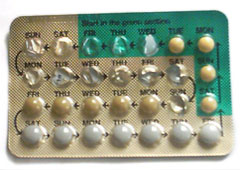
For women who are involved in family planning, some of them must be very familiar with oral contraceptive pill. one of the usage of oral contraceptive pill is it control the pregnancy of women. but how? let us continue reading this article below...
The two hormones in the combined oral contraceptive pill, oestrogen and progestogen work on several levels to prevent pregnancy. Primarily, the Pill works by stopping ovulation (the release of an egg from the ovary). If an egg is not released then of course conception cannot take place. As a back-up, the Pill also makes the mucus released by the cervix thicker so the sperm cannot get through and thins the lining of the uterus so a fertilised egg has difficulty implanting.
The Pill and 'periods'
When a woman takes the Pill her normal menstrual cycle is interrupted. In effect, the Pill tricks the body into believing it is pregnant. When the Pill was being developed, however, it was felt that women would find the lack of a normal menstrual cycle disconcerting. Many women, for example, rely on their regular menstrual period for reassurance of not being pregnant. Consequently, it was decided to have the Pill consist of 21 days of active pills (pills containing the hormones), followed by a pill-free interval of seven days (either no pills or sugar pills). The rapid decline in the artificial hormones which occurs in the pill-free interval results in a 'withdrawal bleed', which somewhat resembles a menstrual period and is often still referred to as a 'period' for simplicity. It is important, however, for women to understand that when they take the Pill the bleeding which occurs during the pill free interval is not a menstrual period.
Similarly, women should be aware the current packaging of the Pill (21 active pills, seven day pill free interval) was developed primarily for acceptability reasons and not because of any physiological reason. Indeed, contraception expert John Guillebaud explains "When you think about it we have here a bizarre contraceptive: one that we providers actually instruct the users not to use - for 25% of the time" (4). As Guillebaud suggests, the pill free interval is the 'Achilles heel' of the Pill's efficacy as it can contribute to pill failure. To stop ovulation from occurring a woman needs to take seven consecutive active pills. In addition, if more than seven days are missed a woman risks ovulation and, if unprotected intercourse occurs, pregnancy. The lengthening of the pill free interval is one of the most common causes of pill failure and is often associated with a woman starting her new Pill packet late. It is very easy to start a pill packet late with women either simply forgetting or not having their new packet with them.
Similarly, if some of the active pills near the end of the previous packet or active pills near the start of the new packet are either missed or not absorbed properly (due to vomiting, diarrhoea, use of antibiotics) this can also mean that there has not been enough pills taken overall to prevent ovulation. Women who miss pills towards the end of their packet often mistakenly believe it does not matter because they are having their 'period' soon. They do not realise that missing pills near the pill free interval may mean they have not taken enough pills to prevent ovulation in the next month. The most dangerous time to miss a pill is at the end or beginning of a packet (because it lengthens the pill free interval beyond seven days).
So why have a pill free interval?
As discussed above, the pill free interval was devised in the early days of the Pill because it was felt that women would find having a 'period' more acceptable. Additionally, all the data on the safety of the Pill was conducted using women who were having a pill free interval (5). If women did not have a pill free interval they would actually be taking more pills a year and, therefore, would be exposed to more of the hormones. For a range of reasons, however, women may choose to tricycle their pill (taking three packets together without a pill free interval), thus reducing the number of withdrawal bleeds a year from 12 to four.
Who could benefit from tricycling?
Women who suffer from headaches or migraines triggered by the sudden drop in hormones during the pill free week and women who experience heavy bleeding may benefit from tricycling. Tricycling is also often recommended for women with endometriosis as it reduces the number of painful withdrawal bleeds and the opportunities for retrograde menstruation (where blood travels in the wrong direction up the fallopian tubes and into the pelvis), thought to be one of the causes of endometriosis. For women who are debilitated by symptoms during the pill free interval, reducing the number of withdrawal bleeds can be extremely beneficial. Tricycling or bicycling (taking two packets together with no pill free interval) can also be useful for women who wish to avoid the withdrawal bleed for special occasions like travel or a honeymoon.
It is important to note that for women taking a fixed dose Pill (all the active pills in the packet are the same) tricycling simply involves taking several packets together without the pill free interval. However, when women are on a phasic Pill (where there are two or three different types of active pills), simply running the packets together can result in break through bleeding (although it will not reduce the efficacy of the contraception). Women taking a phasic pill, therefore, should ask their health care provider about how to tricycle.
if u are interested in learning more about oral contraceptive pill, please visit this website http://www.womhealth.org.au/healthjourney/pill_myths_misconceptions.htm
~ani arina~




No comments:
Post a Comment